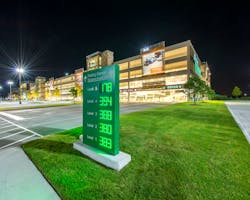Imagine removing the stress associated with driving to the airport: no more worrying if you’ll find a space or how much time it may take. Parking is not only the first and last impression for airline customers, it’s also a major — if not the major — non-aeronautic revenue stream for most major airports. It’s no coincidence that technological advances have made parking easier for motorists and more profitable for owners. How is that happening? Read on.
Wayfinding and Automated Parking Guidance Systems
What if you could tell each of your customers how crowded every one of your garages and lots is before they leave home? As they drive to your airport, imagine telling them that a parking garage just filled up and how many spaces are available at each of the other facilities. When they arrive, you inform them how many spaces are available on each level, and then direct them to a specific available space. Too labor intensive? Actually, you’re doing all this without any staff.
An automated parking guidance system (APGS) is an information network that provides real-time information about space availability and directions at every stage of the parking experience. Magnetic loops, ultrasonic sensors, license plate recognition cameras, and/or digital imaging technologies are used to monitor and calculate space availability and display that information on dynamic signs, websites. and mobile apps. There are three levels of detail:
- Facility counts. As a driver nears the airport, dynamic signage displays real-time space availability (and directional arrows) for each of the parking facilities. If a garage is full, the parker won’t waste time driving to it. Parking rates or other messages may also be displayed.
- Level counts. At each garage, a sign displays the number of available spaces on each. As parkers approach each level, another sign will display the number of spaces on both that level and the next one. “Hmm,” the parker thinks, “only five spaces here, but 135 on the next level. I’m going to the next level.”
- Individual space monitoring. Green lights are displayed above every empty parking space. When a car pulls into a space, the car is detected and the light turns red. Other colors are available, such as blue for handicapped or amber for reserved. Drivers approaching a row of spaces know to bypass that row if there are no green lights. Dynamic signs with arrows strategically placed at key decision points (such as intersections) will let them know how many spaces are available in each direction, enabling parkers to easily locate available parking spaces even when there are only a few spaces available.
When license plate recognition (LPR) cameras are used, vehicle locations are recorded, providing benefits such as lost car assistance. Other benefits include license-plate assigned (reserved) parking areas for employees or VIP customers, and the ability to set location-based parking rates. System software will report trespassers. LPR also enables owners to accurately calculate fees for lost tickets (more on this later).
Thanks to wayfinding and APGS, your customers may never again miss a flight because they couldn’t find parking. If you could choose between two airports and only one had this feature, which would you pick?
Mobile Apps and Reservation Systems
There are more than 4 million mobile applications (apps) out there — you probably have some on your phone. I have parking apps on mine and so do your customers. You can send all the parking information described above to your customers in real time.
Why stop there? Parking reservation systems allow motorists to reserve and pay for parking via the internet or a mobile app. Having a guaranteed space makes it even easier for airport customers to determine how much time to allocate for parking.
Mobile phones can replace parking-gate tickets in facilities. You do this at the gate in the terminal — why not the parking gate? After making a reservation, motorists can receive a QR or bar code that when waved in front of a reader at the entrance, sends a wireless signal to raise the gate. This is repeated at the exit, where the fees are calculated and charged to the credit card on file. License plates and credit cards can also be used to match the car or parker with a reservation.
Off-airport operators have used reservation systems for years, attracting potential on-airport parkers before they get to the airport. Many people research parking by searching their airport and the word “parking.” When they do, off-airport parking usually appears before on-airport parking. This is not random, alphabetical, or geographical. A good reservation system manipulates key search words and search engine optimization so that facilities offering reservations appear at or near the top of the search page.
Reservations capture contact and travel information for marketing purposes. The systems can also incorporate frequent-parker programs and other discounts to build customer loyalty.
Airports in Europe not only offer air and parking reservations online, but also reservations for hotel rooms, car bookings, and marketing opportunities for other airport-related services such as restaurants and retail outlets. Why let Orbitz have all the fun (and the business)?
Ticket and Audit Control via License Plate Recognition
Airports host a lot of long-term parkers, which equates to larger parking fees. If the parker is gone for a number of days (or weeks), there is a greater chance of losing his or her parking ticket, which has traditionally been the only documentation of when a car entered the facility. Unfortunately, the honor system doesn’t work well here. They say time flies when you’re having fun — I suppose that’s why motorists tend to think they were parked for a shorter period of time when they guesstimate their entry dates and times.
Operators traditionally take overnight inventories to assist with lost tickets. Staff manually record the license plate of each vehicle to track the number of days it’s parked. When a lost ticket is reported, staff refer to the inventory. Some enter the data into handheld devices to record the data and some of these devices can digitally scan license plates. This works moderately well, but it’s time consuming and labor intensive. It may cost more in payroll than it saves in lost tickets.
Many airport operators are now using license plate recognition (LPR) systems to photograph and store data from vehicle license plates. These systems are extremely cost effective and safeguard revenues against lost and even swapped tickets.
There are two types of LPR systems: stationary LPR and mobile LPR. Both interface with the parking access and revenue control system (PARCS) for audit control.
Stationary LPR uses mounted cameras at the entrance and exit points of a facility. The cameras capture the license plate images of cars as they enter the facility. When the ticket is surrendered at the exit, the vehicle’s license plate is compared with the image that was recorded at the entrance. If a different ticket is used at the exit, the vehicle’s license plate won’t match the entering vehicle’s license plate, which creates an alarm condition. The software can then be directed to search for the matching license plate image to determine the corresponding entry ticket data (date and time). This provides for accurate fee calculations in the event of lost tickets and eliminates the possibility of drivers exchanging tickets in an attempt to reduce the parking fee.
Stationary LPR also enables the vehicle’s license plate to serve as a parking credential. Rather than pulling a ticket, the LPR system can record the license plate and automatically raise the gate. The license plate image replaces the ticket. We may lose tickets, but it’s unlikely we’ll lose our license plates! License plates can also replace monthly parking credentials, such as proximity cards but it is not perfect and a back-up system (ticket dispenser, proximity card reader, etc.) will still be required in the event of a misread.
Mobile LPR uses vehicle-mounted cameras to record license plate images of all parked cars as the vehicle drives through the facility. The data is synchronized with the previous day’s data to track the duration of stay for each vehicle. If the facility is separated into zones and the vehicle drives the same route each night, the system can locate vehicles by querying their license plates.
Credit Card In/Credit Card Out
Another option for minimizing lost tickets is getting rid of them entirely. Credit card in/credit card out systems have a parker swipe a credit card rather than taking a ticket. The software timestamps the transaction, ties it to the credit card, and stores it until the parker returns and swipes the credit card at the exit. The software then retrieves the entrance data, calculates the fee, and charges the credit card. No cashier is needed so this can be an automated exit lane. Make it a dedicated express lane to give frequent flyers the added bonus of bypassing lines at cashiered exits.
Pay-on-Foot Parking
If you’re still using cashiers, payroll is one of your largest operating expenses. Pay-on-foot (POF) systems replace cashiers with automated payment machines that don’t require meal breaks, never take sick days, and rarely talk back (except for automated prompts).
As the name suggests, the parker walks up to the POF before returning to his or her car. The POF is strategically located so parkers will walk past it or near it on the way back to their cars. The parker inserts the ticket (received upon entering the garage), which is read by a fee computer that calculates the fee. The POF uses visible and audible messaging to guide the parker through the payment process. The audible messages can be programmed in multiple languages. POFs can accept cash, credit cards, debit cards, smart cards, or validations.
The ticket is validated as paid and returned to the motorist. A receipt is provided upon request. The POF advises the parker to insert the validated ticket at the exit verifier at the garage exit. and an intercom button is available in the event the parker needs assistance. The parker returns to the car, drives to the exit gate, and inserts the validated ticket into the exit verifier, which also uses visible and audible messaging. Upon confirming the validated ticket, a signal is sent to raise the exit gate.
The POF allows for a predetermined grace period (i.e.:20 minutes) to allow the motorist enough time to return to the car and drive to the exit. If the time expires, the motorist will be prompted to pay an additional fee for the additional time parked. The exit station can process credit card payments. This ensures that the parker pays the appropriate fees (rather than intentionally paying for parking before leaving in an effort to pay a lower fee), and also enables parkers who neglected to pay at the POF to pay at the exit.
If you haven’t implemented some of these technologies--and others we haven’t covered here--you may be losing market share to an airport that has!
Dan Kupferman, CAPP is the Director of Car Park Management Systems Walker Parking Consultants. For the latest information about technology that is available now and will be in the near future, the parking industry trade association, the International Parking Institute, offers publications, resources, courses, conferences, and airport parking-specific forums. Learn more at parking.org.




